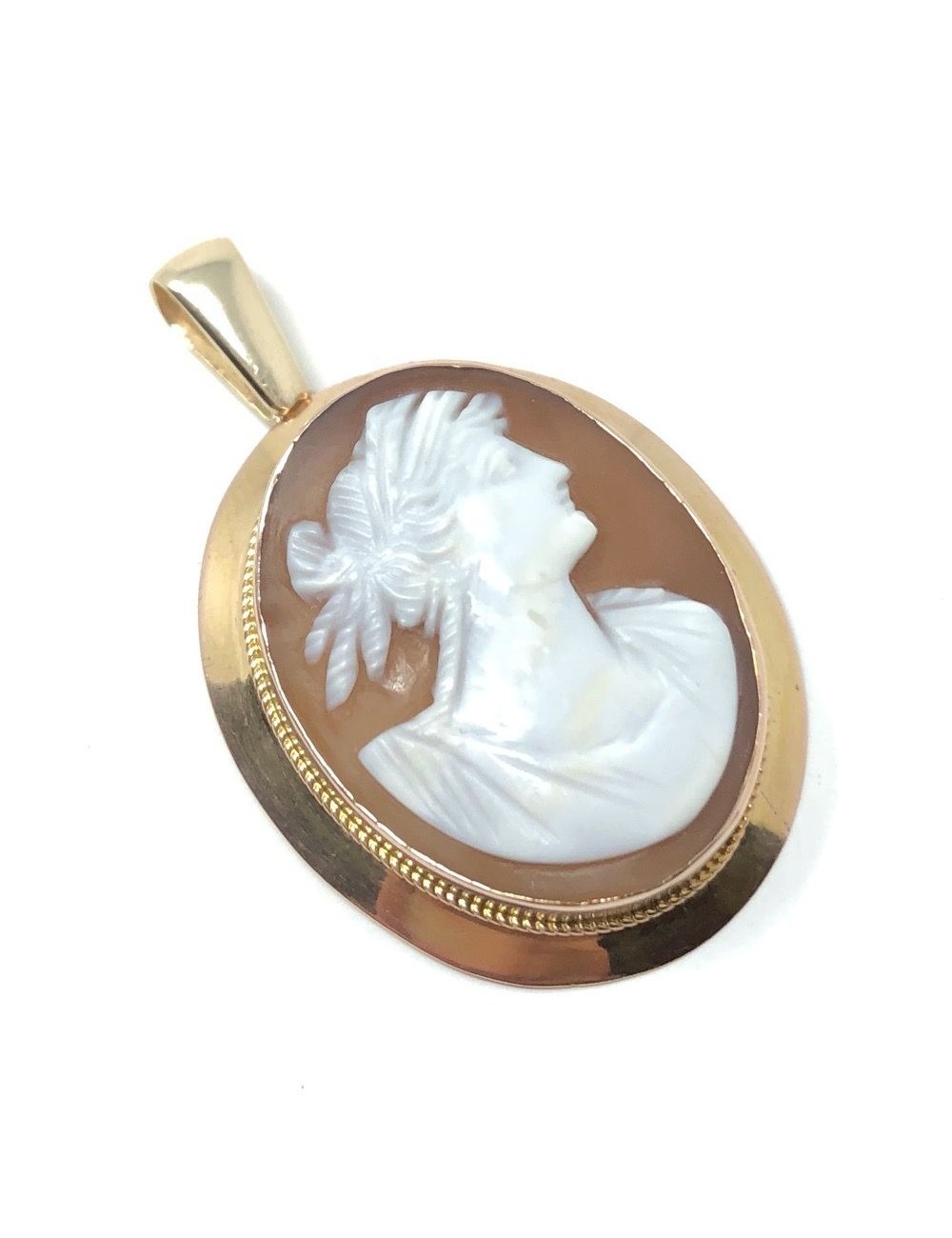- On sale!
- -25%











This beautiful pendant was created in the late 1800s. It was most likely made by William Neale.
Condition Report:
Very Good - A tiny area of rippling to the gold plating to the top right of the pendant. This is only visible upon very close inspection and does no detract from the overall appeal of the piece.
For more information about this pendant, read below...
The Details...
Constructed from 9ct gold, this pendant features a shell cameo detailed with the profile of a classical woman. The reverse of the pendant is stamped '9ct' and with the initials 'WN'. This pendant measures 3cm x 3.75cm.
A Short History...
The maker's mark 'WN' on the reverse of this pendant, most likely stands for William Neale. He established his firm in 1850 in Birmingham.
Wear it With...
Add this pendant to your favourite chain and add other charms to compliment it.
The jewellery within the Gemma Redmond Vintage collection has survived to this day because it has been well cared for throughout its lifetime. It is important to continue to care for the jewellery that you buy from us to ensure its continued preservation. Here are some suggestions:
- Be sure to store your jewellery within the boxes that we provide to ensure that it is protected. This is especially important when travelling with your pieces.
- Try not to get perfume or hairspray on your items. These liquids can damage the materials that our jewellery is made from.
- Try not to drop your jewellery or catch your jewellery against hard surfaces. If this happens over time, the findings and fixings can loosen and wear.
- Try not to get your jewellery wet. Some costume jewellery manufacturers utilised water soluble glue in the making of their pieces. Getting your jewellery wet could cause rhinestones and other details to fall away over time.
- If you wish to clean your jewellery, use a soft polishing cloth or a soft brush.
This elegant necklace reflects the craftsmanship and eye for detail characteristic of Czechoslovakian jewellery design.
Condition Report:
Excellent
For more information about this necklace, read below...
This beautiful necklace was created c.1900. It features an asymmetrical design, known as négligée, which was very fashionable at the turn of the 20th century.
Condition Report:
Excellent
For more information about this necklace, read below...
This wonderful example of Françoise Montague jewellery dates from c.1962.
Condition Report:
Excellent
For more information about this necklace, read below...
This is a delightful example of a 1920s tasseled flapper necklace.
Condition Report:
Very Good - Some darkening to the silk thread due to age. This is only apparent upon close inspection and does not detract from the appeal of the necklace.
For more information about this necklace, read below...
This beautiful cut steel pendant dates from the Georgian era.
Condition Report:
Excellent
For more information about this pendant, read below...
This stylish necklace was made in the 1990s in France by the Inès de La Fressange brand.
Condition Report:
Excellent
For more information about this necklace, read below...
This necklace dates from the 1930s and was made in Czechoslovakia. It features collectible mirror glass.
Condition Report:
Excellent
For more information about this piece, please read below...
This beautiful necklace, reflects the craftsmanship and eye for detail characteristic of Czechoslovakian jewellery design.
Condition Report:
Excellent
For more information about this necklace, read below...
This striking necklace, featuring a stylish combination of black and Carnelian glass, dates from the 1930s.
Condition Report:
Very Good - Some wear to the metal plating on the reverse. This is not visible when the necklace is worn and does not detract from the appeal of the piece.
For more information about this necklace, read below...
This striking necklace most likely dates from the Art Deco revival of the 1970s.
Condition Report:
Excellent
For more information about this necklace, read below...
This dramatic necklace was most likely created in the 1970s.
Condition Report:
Excellent
For more information about this necklace, read below...
This rare and stylish example of an Art Deco era uranium glass necklace was most likely created in Czechoslovakia.
Condition Report:
Excellent
For more information about this necklace, read below...
This beautiful pendant was created in the 1800s.
Condition Report:
Very Good - Some darkening in colour to the central paste stone. This is consistent with age and does not detract from the appeal of this rare piece.
For more information about this pendant, read below...
This rare design glass bead necklace represents elegant Art Deco craftsmanship.
Condition Report:
Excellent - The necklace has been professionally re-strung.
For more information about this necklace, read below...
This beautiful black glass locket is an entirely original, elegant antique.
Condition Report:
Very Good - There is a tiny chip to the edge of one circular and one triangular panel. This is only visible upon very close inspection and does not detract from the overall appeal of the piece.
For more information about this necklace, read below...
This wonderful example of early plastic jewellery is in fabulous condition.
Condition Report:
Excellent
For more information about this necklace, read below...

This beautiful pendant was created in the late 1800s. It was most likely made by William Neale.
Condition Report:
Very Good - A tiny area of rippling to the gold plating to the top right of the pendant. This is only visible upon very close inspection and does no detract from the overall appeal of the piece.
For more information about this pendant, read below...